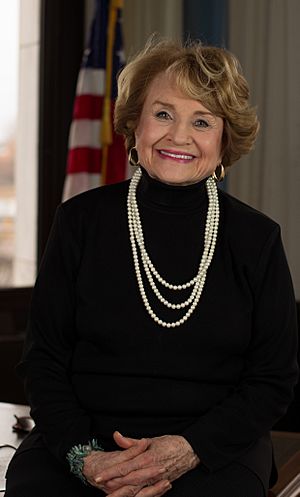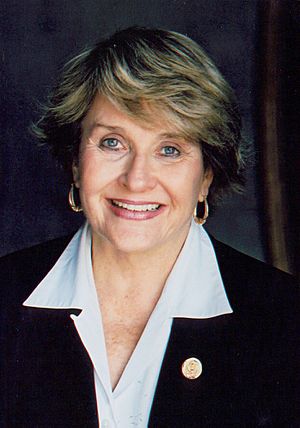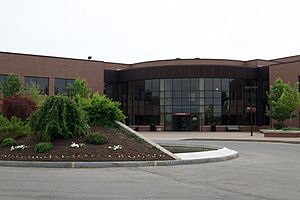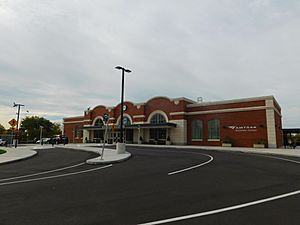Louise Slaughter facts for kids
Quick facts for kids
Louise Slaughter
|
|
|---|---|
 |
|
| Chair of the House Rules Committee | |
| In office January 3, 2007 – January 3, 2011 |
|
| Speaker | Nancy Pelosi |
| Preceded by | David Dreier |
| Succeeded by | David Dreier |
| Member of the U.S. House of Representatives from New York |
|
| In office January 3, 1987 – March 16, 2018 |
|
| Preceded by | Fred J. Eckert |
| Succeeded by | Joseph Morelle |
| Constituency | 30th district (1987–1993) 28th district (1993–2013) 25th district (2013–2018) |
| Member of the New York State Assembly from the 130th district |
|
| In office January 1, 1983 – December 31, 1986 |
|
| Preceded by | Thomas A. Hanna |
| Succeeded by | Robert L. King |
| Personal details | |
| Born |
Dorothy Louise McIntosh
August 14, 1929 Lynch, Kentucky, U.S. |
| Died | March 16, 2018 (aged 88) Washington, D.C., U.S. |
| Political party | Democratic |
| Spouse |
Robert Slaughter
(m. 1957; died 2014) |
| Children | 3 |
| Education | University of Kentucky (BS, MS) |
Dorothy Louise Slaughter (born McIntosh; August 14, 1929 – March 16, 2018) was an American politician. She served as a U.S. Representative for New York for 16 terms. She was in office from 1987 until her death in 2018.
Louise Slaughter was born in Lynch, Kentucky. She studied microbiology and public health at the University of Kentucky. She earned both a Bachelor's and a Master's degree. After moving to New York, she became involved in politics. She was a member of the Democratic Party.
In 1982, she was elected to the New York State Assembly. In 1986, she was elected to the U.S. House of Representatives. She represented Rochester and parts of Monroe County. She was often the only microbiologist serving in Congress.
Slaughter led the House Rules Committee from 2007 to 2011. She also worked on important laws. She was the main House sponsor of the Genetic Information Nondiscrimination Act in 2008. She also helped create the Violence Against Women Act with Senator Joe Biden. At the time of her death, she was the oldest member of Congress.
Contents
Early Life and Education
Louise Slaughter was born Dorothy Louise McIntosh. Her birthday was August 14, 1929. She grew up in Lynch, Kentucky, a coal mining town. Her father was a blacksmith for a coal mine.
She had two brothers and two sisters. Her sister Virginia died from pneumonia when they were children. This sad event inspired Louise to study microbiology and public health.
After high school, Louise went to the University of Kentucky. She earned a bachelor's degree in bacteriology. Then, she earned a master's degree in public health. Her master's work focused on how antibiotics were being used too much. After college, she worked for a company called Procter & Gamble.
Starting Her Political Journey
Louise Slaughter was already active in her community. She was part of groups like the scouts and the League of Women Voters. She became more interested in local politics. She joined an environmental group that promoted recycling.
Slaughter decided to run for the Monroe County Legislature. She won on her third try in 1975. While serving there, she also worked for New York Secretary of State Mario Cuomo. When Cuomo became lieutenant governor, she continued to work for him.
In 1982, she ran for the New York State Assembly. She won against the Republican leader, Thomas A. Hanna. She was re-elected in 1984.
Serving in the U.S. House of Representatives
Becoming a Congresswoman
After four years in the State Assembly, Louise Slaughter decided to run for Congress. She ran for the Democratic nomination in New York's 30th congressional district. This district included Rochester and parts of nearby counties.
In 1986, she won the election against Fred J. Eckert. She became the first Democrat to represent that district since 1963. In 1988, she won re-election with even more votes.
Over the years, the boundaries of her district changed. After the 1990 census, her district became the 28th District. It included more of Rochester and became a strong Democratic area. Later, after the 2000 census, her district merged with another.
After the 2010 census, her district was renumbered as the 25th District. It covered most of Monroe County. In 2012, she faced a tough challenge but won her 14th term. In 2014, she won by a very small number of votes. She won again in 2016.
Key Achievements in Congress
Louise Slaughter began her time in Congress in January 1987. She was a strong supporter of medical research. She also championed women's health and genetic rights.
In 1993, she helped secure $500 million for breast cancer research. This funding went to the National Institutes of Health. She also fought to make sure women and minorities were included in all federal health clinical trials. Before this, most research was done only on white males. She helped create an Office of Research on Women's Health at NIH.
In 1994, she co-wrote the Violence Against Women Act with Senator Joe Biden. This law helps reduce domestic violence and supports victims. She also helped create the Women's Progress Commemorative Commission in 1998.
After 2006, Democrats took control of the House. Slaughter was chosen to lead the United States House Committee on Rules. She was the first woman in history to chair this important committee. She served in this role until 2011.
In 2007, she introduced the Preservation of Antibiotics for Medical Treatment Act (PAMTA). This bill aimed to limit the use of antibiotics in animal feed. She wanted to stop the growth of bacteria that resist antibiotics. She said her science background made her care deeply about this issue.
Slaughter strongly supported the Genetic Information Nondiscrimination Act of 2008. This law stops employers and health insurers from discriminating based on a person's genetic information. She worked on this bill for 14 years before it became law.
In 2009, she asked the United States Department of Defense to investigate faulty body armor. This led to the recall of 16,000 pieces of body armor. They were replaced with safer ones.
Slaughter was the chairwoman of the House Rules Committee during the creation of the Patient Protection and Affordable Care Act. She helped manage the rules for this important healthcare law.
In 2011, Slaughter helped get $62.5 million in federal funding. This money went to the Laboratory for Laser Energetics at the University of Rochester. The Rochester Institute of Technology named a building after her to honor her efforts.
After the shooting of Gabby Giffords in 2011, Slaughter called for better control of harmful language.
She also wrote the Stop Trading on Congressional Knowledge Act, or STOCK Act. This law was passed in 2012. It stops members of Congress from using secret information for their own profit. It also requires them to report many financial deals quickly.
Louise Slaughter was known as one of the most liberal and progressive members of Congress from New York. At the time of her death, she was the oldest member serving in Congress.
Committee and Group Memberships
- United States House Committee on Rules (Ranking Member)
- Party leadership
- At-Large Whip
- Caucus memberships
- Congressional Arts Caucus Co-chair
- House Baltic Caucus
- Afterschool Caucuses
- Congressional NextGen 9-1-1 Caucus
Slaughter was also a former Co-Chair of the Congressional Caucus for Women's Issues.
Personal Life and Legacy
Louise met Robert "Bob" Slaughter while traveling for work. They married in 1957. They moved to Fairport, New York, a suburb of Rochester. They had three daughters. Bob Slaughter passed away in May 2014.
Even after living in New York for many years, Louise Slaughter still spoke with a strong Kentucky accent.
On March 14, 2018, she was taken to the hospital. She had a concussion after falling at her home. Two days later, on March 16, Louise Slaughter passed away at age 88.
Her funeral was held at the Eastman Theater in Rochester. More than 2,000 people attended. Important speakers included House Minority Leader Nancy Pelosi and former Secretary of State Hillary Rodham Clinton.
After her death, leaders asked Amtrak to rename its Rochester station in her honor. Louise Slaughter had played a big part in getting funding for the new station. The station was renamed the Louise M. Slaughter Rochester Station on March 25, 2019.
Awards
- Foremother Award from National Center for Health Research, 2014
- Induction into the National Women's Hall of Fame, 2019
See also
 In Spanish: Louise Slaughter para niños
In Spanish: Louise Slaughter para niños
- Self-executing rule
- List of United States Congress members who died in office
- Women in the United States House of Representatives





